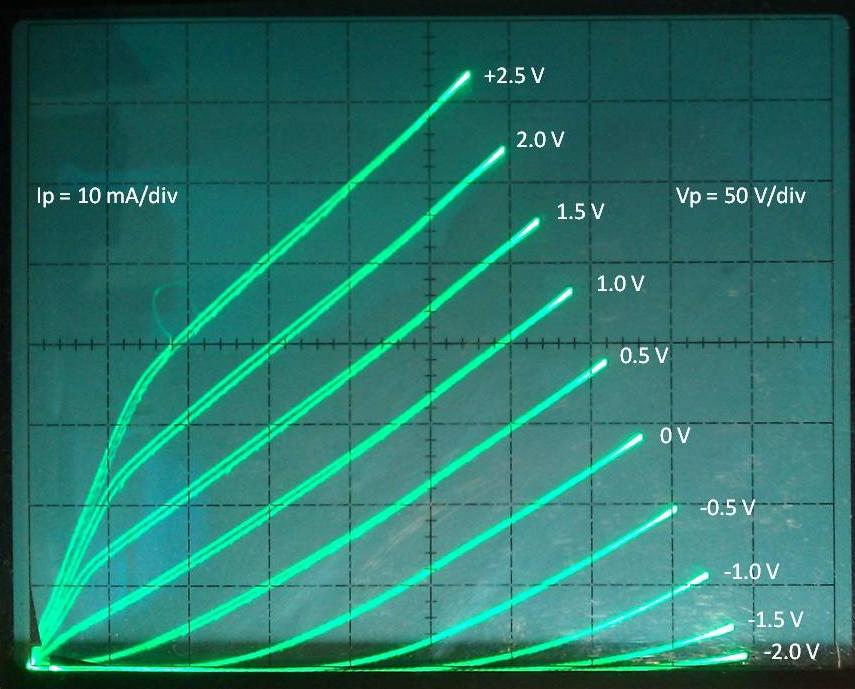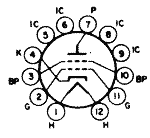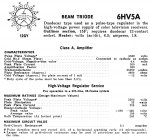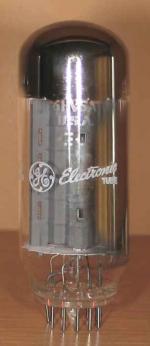
6HV5A
|
|
|||||||||||||||||||||||||||||
|
Hits: 5239 Replies: 2
6HV5A Forward grid bias
|
|
|
Joe Sousa
10.Jun.11 |
1
Fellow Radiophiles: The 6HV5A High Voltage Beam triode is another example of the type discussed in the 6JD5 Forward Grid Bias thread. The 6HV5A is equivalent to 6HV5=6HS5=6JK5. The principal difference between the 6HV5=6HV5A=6HS5=6JK5 group and the 6JD5=6HZ5=6JH5 group is sightly lower heater current and slightly higher gm for the former. But in forward grid bias operation the 6HV5A shows a substantially different behaviour with worse linearity. The following plots serve to compare these differences directly with the plots shown in the 6JD5 Forward Grid Bias thread.
These curves were taken with the suppressor beam plates G2 connected to the Anode, as was done for the 6JD5. The plot above shows the μ of the 6HV5A is only 200V/V with 100V at the plate, and 0V at the grid, while the μ for the 6JD5 was a little higher, at 250V/V at a similar bias. The forward bias characteristic is markedly different between the 6HV5A shown here in the 6JD5. The conduction characteristics of the grid as seen in the plot on the left are also much more dependent on plate voltage.
It is possible that some of the reason for the difference in characteristics stems from the wear on the used 6HV5A tube I curve-traced. However, the left most sweep in the grid sweep plot with A=G2=50V is virtually identical to the same sweep in the 6JD5, thus suggesting similar emission. While this 6HV5A will work as a power amplifier with forward grid bias, the 6JD5 will give much more linear performance, which is to say that it will produce much less harmonic distortion. The worsened performance of the 6HV5A caused me to repeat the same curve traces with the suppressor beam plates G2 grounded. The linearity performance was even worse, as seen in the first of the following plots. Grounding the suppressor grid increases grid current, as expected, but also reduces the plate current at lower voltages.
Regards, -Joe |
|
Joe Sousa
24.Jun.11 |
2
Fellow Radiophiles: I found a new 6HV5A by GE. The new curves show linearity that is comparable to the 6JD5. The non-linearity seen above could be caused by wear in the tube. Regards, -Joe |
|
Robert Weaver
26.Jun.11 |
3
Here's another set of curves for a 6HV5A, which in the overall scheme of things, is out of chronological order. Joe knows the story behind it because we've been emailing back and forth on the subject. So I'll try to explain: 
This 6HV5A curve trace was provided courtesy of Chuck Doose, with whom I'd been corresponding regarding the construction of a vacuum tube audio amplifier. I'd mentioned to him, Joe's posts on the 6JD5 and the subsequent post here on the used 6HV5A. Chuck happened to have a couple of NOS 6HV5A's, and conveniently, a Tek 577 curve tracer. He sent me this trace which I forwarded to Joe.
Now, I hadn't seen any reason to post it because Joe's subsequent 6HV5A traces confirmed the linearity of the NOS tubes, but Joe pointed out that the difference was that this one goes up to 450 volts on the plate, and therefore provides some additional useful information.
Attachments
|
End of forum contributions about this tube
| Data Compliance | More Information |














